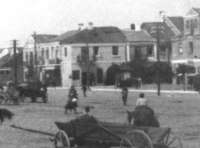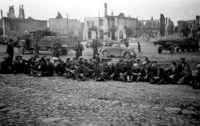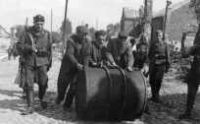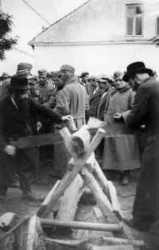

 |
 |
 |
 |
 |
 |
 |
| Zwolen Market-place |
 |
| Zwolen Market-place, 16 Sep 39 |
On 6 September 1939, Zwolen was heavily bombed by the Deutsche Luftwaffe for the first time. The second air attack, coinciding with a bombardment by German artillery, took place two days later. Almost 80% of the town was destroyed.
The destruction of Zwolen was an interesting subject for German soldiers. They took many photographs of soldiers, Jews, and non-Jews who lived in a poor condition.
Shortly after entering Zwolen, German soldiers burned a group of Jews alive in a barn. The economic persecution of the Jews also began immediately. The Nazis confiscated Jewish property, and Jews were forced to pay very high "fines". The synagogue in Zwolen, which had been severely damaged during the bombing of the town was totally destroyed at the beginning of the occupation.
As in other towns and cities throughout German occupied Poland, Jews from Zwolen were conscripted for forced labour.
 |
| Forced Jews in Zwolen, 17 Sep 39 |
 |
| Forced Jews in Zwolen, in September 39 |
In 1942, a group of young men and women were selected in Zwolen and sent to the work camp in Skarzysko-Kamienna. The camp belonged to the HASAG company and prisoners worked there producing muntions for the German army.
The final liquidation of the Zwolen ghetto took place on 29 September 1942. The Jews had to walk 15 km to the Garbatka railway station and from there they were deported to the death camp in Treblinka.
During the liquidation of the ghetto and on the way to the railway station, about 200 Jews were executed. Mainly old and sick people who were not able to walk to the train were killed at the Jewish cemetery. Among those executed on the spot were also those who attempted to escape.
A last group of approximately 100 people was left in Zwolen, their task being the cleaning of the ghetto area. After completing this work, all of them were sent to a labour camp.
In 1944 the Jewish cemetery was destroyed. During its destruction the Germans also liquidated all traces of the mass executions that had been conducted there.
Trial:
Case Nr.1041
Crime Category: War Crimes, Other Mass Extermination Crimes
Accused:
Schuster, Albert Hugo Death Sentence Rehab: Sentence reduced to life imprisonment
Court:
LG/BG Karl-Marx-Stadt 730209; Ob. Gericht der DDR 730406; LG/BG Chemnitz 941010
Country where the crime was committed: USSR, Poland
Crime Location: Nowogrudok, Bielowiec, Bodzentyn, Bodzentyn-Celiny, Debno, Grabkow, Huta-Sklana, Jeziorko, Klonow, Krasnik-Wysokie, Nowa-Slupia, Opoczno, Parczew, Psary-Podlesy, Swietla-Katharczyna, Tarczek, Woiciechow, Wola-Szczygielkowa, Wywoz, Zwolen
Crime Date: 12/1941, 08/1942 - 12/1944
Victims: Prisoners, Jews, Gypsies, Civilians
Nationality: Soviet, Polish
Office: Gendarmerie platoon (mot.) 7, Gendarmerie battalion. (mot.) 1, Gendarmerie platoon (mot.) 62
Subject of the proceeding: Participation in herding together and deporting Jews from Nowogrudok. Seizure, mishandling, deportation and shooting of civilians during patrols, during the systematic search of areas suspected of partisan presence as well as in the course of so-called village inspection raids within the context of anti-partisan warfare ("Bandenbekämpfung") in the Radom district. Summary execution of prisoners. Shooting of a group of men, women and children (Gypsies and Jews) discovered incidentally during a patrol. Shooting of village inhabitants as reprisal for a nearby partisan attack. Arrest of civilians as hostages for family members who could not be found (the hostages were later shot).
Sources:
Pawel Nakonieczny
DDR-Justiz und NS-Verbrechen - Nazi Crimes on Trial
Photos:
Zbigniew Lesisz: O Zydach Zwolenskich, Zwolen 1999
Pawel Nakonieczny
© ARC 2005